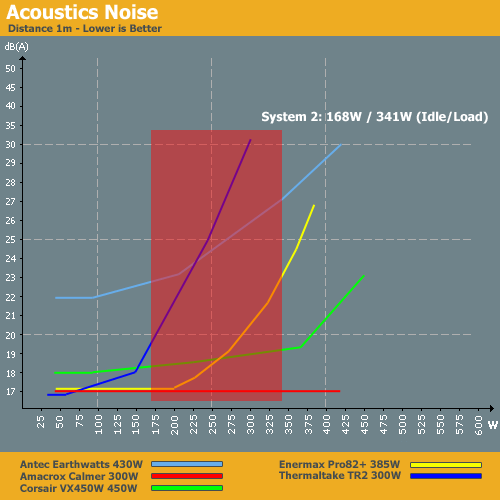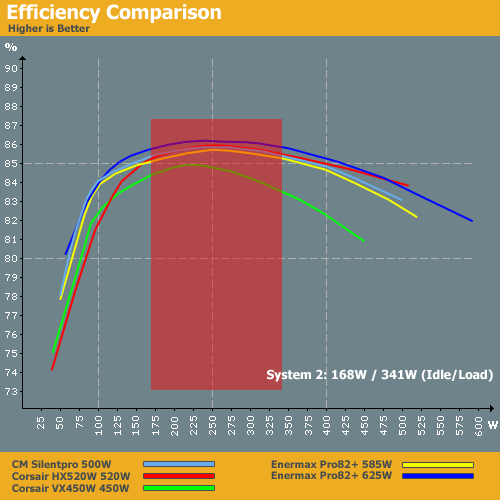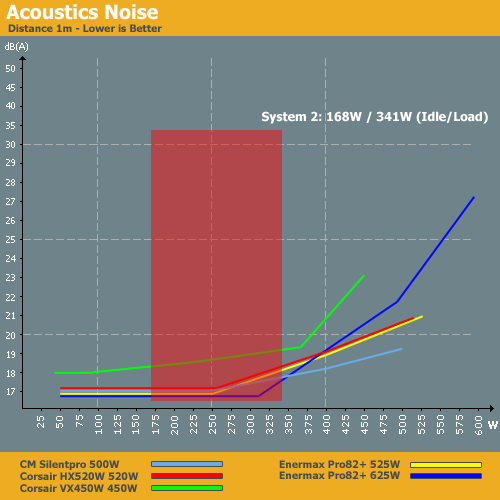Debunking Power Supply Myths
by Christoph Katzer on September 22, 2008 3:00 AM EST- Posted in
- Cases/Cooling/PSUs
PSUs for Midrange Systems
Our midrange system opens up a lot more in the way of potential power supplies, as there are far more manufacturers building 400W to 500W PSUs. Our idle power consumption in this case is 168W, which is quite high when compared to the 120W a high-end system would have used a few years back (i.e. AMD Athlon 64 4000+ and NVIDIA GeForce 7800 GTX under full load). However, times change and we see increased power requirements along with performance improvements.
Our selection of power supplies uses the same criteria as before. We will also see how our entry-level power supplies and all this sort of system.
- Cooler Master Silent Pro (500W) actively cooled
- Corsair HX520W (520W) actively cooled
- Corsair VX450W (450W) actively cooled
- Enermax Pro82+ (585W) actively cooled
- Enermax Pro82+ (625W) actively cooled


In terms of efficiency as well as the ability to supply sufficient power, all of the power supplies are able to run this midrange setup except for the 300W Thermaltake unit. The Antec Earthwatts has been around for a while, so it's not surprising that it doesn't perform as well as newer models, but it still delivers decent if not great efficiency. Noise levels are a different matter, and we would be inclined to avoid most of the entry-level PSUs. If noise isn't a consideration, all but the Antec will work; however, the Corsair VX450W performs best out of these units in so we will carry it along to the next level and include it with the midrange offerings.
Efficiency is Not the Issue

With the addition of some higher performing power supplies, efficiency clearly shouldn't be the overriding concern for a computer like our midrange system. The Corsair VX450W doesn't look as good in this graph, although 83% efficiency certainly isn't anything to cry about. The newer models all reach efficiency of around 85% to 86% throughout the midrange system load. Comparing the two scenarios, outside of PSUs that simply can't provide enough power it's not necessary to move up to a higher performance power supply. You want to look at other aspects such as features, warranty, and noise levels before making a decision.

In terms of noise levels, all of these units perform very well and can provide a quiet computing environment. We also see a clear separation between the entry-level PSUs in the midrange PSUs in this chart, since the midrange units are running a 75% load at worst. Again, if you've had the mindset that 600W and higher PSUs are required for modern midrange systems, the above charts should help dispel that myth. If you can find a good quality 400W PSU, it can easily power a midrange system. However, 500W PSUs generally make the best fit, as they provide optimal efficiency and lower noise.










98 Comments
View All Comments
computerfarmer - Tuesday, September 23, 2008 - link
Good article! Based on the number of comments, this has many of us thinking. This gives a way of figuring out our needs vs bigger is better.This article gives us enough information to make educated choices. Looking at the 12V rails is a good place to start along with total power. With a single 12V rail like Corsair VX series, the amount each rail carries is a non issue.
A rule I have always followed is to use a power supply with at least 20% more power than the maximum required.
dragosmp - Tuesday, September 23, 2008 - link
Hey, I just wanted to say that after posting this link on OCN, there were tenths of replies. People want to know how much various things consume, as all this 1kW PSU hype hype is getting very tiresome.I for one would be curious how did you measure the current thru the PCIe slot - have you modified the slot to access the power lines? Soldering geeks would really like to know :)
And lastly, browser compatibility. This comment is very hard to write in Chrome (writing overlapping), maybe you or google will fix this.
Cheers,
Dragosmp
Fudus - Tuesday, September 23, 2008 - link
I am stupid and run my 4850 off a 300W power supply, with a sata power>molex>pci-E power connection. Go Go overloading!It seems to work at stock speeds under stress as well for some reason. I really didn't expect it to work this well (C2D e6550, Radeon 4850,300W power supply, 2GB RAm, G33 motherboard, 1 HD/DVD+RW)
marc1000 - Tuesday, September 23, 2008 - link
you are not stupid, Fudus. if you sum the power for your c2d (never more than 65w), mobo (40w), ram+HD+DVD (5+15+10) you have 135w. then add the 4850 and you are still fine with a 300w PSU. Like i Said before, I have a 90W CPU (that old Pentium-D, argh!) but run a radeon 3850, so my system consumes about the same energy as yours. and the 300w is working fine with me too. or else I would be a stupid too =Pdragosmp - Tuesday, September 23, 2008 - link
Wow, this gives me hopes to mount a 4670 on a 120W pico-atx powered rig.How is the noise, the +12V level?
oopyseohs - Monday, September 22, 2008 - link
I have seen upwards of 700W while testing on old QuadFX systems with 8800Ultra SLI. I would imagine that Skulltrail overclocked to 4.0GHz (easy) and 2x Radeon HD4870X2's in CrossFireX would demand significantly more than 700W. Of course these systems are rare, but they do technically validate the "need" for power supplies that output 1000W+.In any case, thanks for this article. I think it does a great job of showing why ultra high-output power supplies are not even close to necessary for 99.9% of the computing world.
JarredWalton - Monday, September 22, 2008 - link
I have a Q6600 @ 3.42GHz with dual 3870 cards, and that peaks at around 650W at the outlet. Certainly there are plenty of overclocked PCs that can draw more than 700W... but once you take efficiency into account, my PC is only really using around 520W. I've also tested high-end water-cooled setups with 8800 GTX SLI that topped out at 650-700W power draw as well. I personally think with ultra high-end PSUs that having six 12V rails isn't very useful as well - some of the problems people experience with lesser PSUs simply comes from 12V rail distribution.If you're running dual GTX 280 cards and a quad-core (probably overclocked) CPU, I don't think there's anything wrong with 1000W PSUs. In fact, I know Gary has blown a few 1000W PSUs with his overclocking testing in the past. However, I'm running perfectly happy now with a 3.2GHz quad-core and really don't need even that much CPU performance; it's all about the GPU for games, and CPUs are only really taxed in 3D rendering and video encoding it seems.
Griswold - Monday, September 22, 2008 - link
Now that you made that clear, give us some of your great reviews for reasonably dimensioned PSUs instead of these 600-1000W bricks. :Pwhatthehey - Monday, September 22, 2008 - link
Maybe it's just me, but I sort of got the impression that the reason for this article is precisely that Anandtech is tired of only getting the highest-end power supplies for testing. It's all marketing BS of course: they don't want to limit sales of the $300 1000W PSUs so they only send those out for testing.Or maybe the truth is more nefarious: they figure if they send out a top-quality 1000W PSU that has great efficiency and voltage regulation, unsuspecting buyers will buy their lower wattage parts that might not be all that great? The first is more likely, but it wouldn't surprise me if some of the less expensive 400-500W PSUs (even from major brands) use much cheaper components. Which is why we all want to see them tested, and probably also why the companies don't want to send them out for review.
Martimus - Monday, September 22, 2008 - link
Since this article is about choosing a PSU for a new computer build, it would have been nice to include new components like the P45 chipset, or the new nVidia or AMD graphics cards. I started reading it with the hope of knowing how well the Antec Earthwatts 500W PSU that came with the Sonata III case I bought would be do with various build options. The problem was that with only old equipment being used, I couldn't come to any real conclusion. It seemed to read more like a report to prove a point rather than an actual guide written to help with a new computer build. I am not trying to berate the article, but I just don't see the point of it.